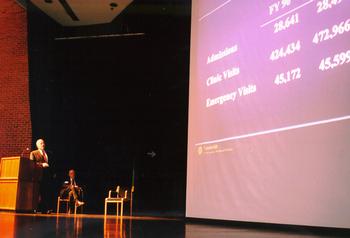Medical center's performance outlined

Dr. Harry Jacobson addresses the VUMC faculty. (Photo by Donna Jones Bailey)
A detailed look at the present and a bold vision of the future of Vanderbilt University Medical Center were outlined at this week's Joint Faculty Meeting.
With more than three hundred faculty members in attendance at Langford Auditorium, Dr. Harry R. Jacobson, Vice Chancellor for Health Affairs, painted a picture of where the institution stands now, where it's headed and what it's going to take to get there.
Packed with hitherto unseen financial and market information, the session also served as a forum to announce several promotions ‹ Lee E. Limbird, Ph.D., professor and chair of Pharmacology, has been named associate vice chancellor for Research. Dr. Raymond F. Burk, professor of Medicine, has been named director of the newly formed Vanderbilt Center for Molecular and Clinical Nutrition. Dr. Raymond N. DuBois Jr., professor of Medicine, has been named director of the Division of Gastroenterology.
(see related story)
The medical center's current position in today's competitive and volatile health care market is strong. Admissions to Vanderbilt University Hospital, outpatient visits to The Vanderbilt Clinic, emergency room visits, average length of patient stays, average charges, and share of federal research dollars are all extremely positive, and reflect the hard work done in recent years to streamline the institution's procedures.
Admissions for the most recently concluded fiscal year reached 28,496. That figure may hit 30,000 by the time the current fiscal year ends June 30. Outpatient clinic visits, of which there were 472,966 last year, are expected to top the half-million mark this year ‹ for a facility that was expected to handle only about 300,000 visits per year when it was opened 10 years ago.
"This is the reflection of the remarkable efforts by all those involved in the cost-reduction efforts of the last few years," Jacobson said. "We've done a great many positive things, but there is still much more that needs to be done."
Tennessee's move to TennCare four years ago has squeezed the institution's ability to fund patient care services. In each of the last four years, VUMC has lost more than $15 million in providing care to the state's neediest citizens in essential services like the trauma center, the Neonatal Intensive Care Unit, LifeFlight and the burn center. The solution, according to Jacobson, is to grow, to expand VUMC's reach into the region and take better advantage of the medical center's unique resources.
Among significant strategic projects set to get under way in the near future are:
€ planning for a new free-standing Vanderbilt Children's Hospital
€ implementation of the Vanderbilt Page-Campbell Heart Institute
€ completion of the Clarksville Regional Hospital Cancer Center Affiliation
€ planning for the new Bill Wilkerson Center
€ planning for the Musculo-skeletal Institute
€ formulation of a plan for an Addiction Center
€ development of a strategy for Geriatrics
The strategy of growth also applies to VUMC's research mission. It has been proposed that the National Institutes of Health will, over the next 10 years, double its funding to the nation's research institutions. Last year, VUMC received nearly $90 million in sponsored research and another nearly $30 million in non-sponsored research. Both these funding sources are expected to grow during the next decade.
"In the next 10 years, we could be up to $300 million in total research funding," Jacobson said. "We need to plan for that or it won't happen. Competition will be fierce, but there will also be many opportunities."
This projected growth can't be accomplished without a corresponding commitment to Vanderbilt's education programs. Recent new initiatives, such as VUSM's M.D. with thesis program to allow students more access to research opportunities, will help pave the way toward tomorrow's growth.
"We cannot become the kind of research institution we want to be without growing our graduate education program," Jacobson said. "When the research enterprise grows by 150 percent over the next 10 years, we will need to recruit ‹ and develop ‹ new faculty. After all, today's graduate students are tomorrow's associate professors."
Technology transfer ‹ translating scientific discoveries into new therapies as quickly as possible ‹ and the development of new businesses involved in biotechnology, pharmaceuticals, medical devices, health care software applications and health care services are revenue streams that also need to be nurtured and expanded.
"Right now we are 62nd in the country in royalties. We really want to improve that and promote the ideas and ventures of the institution's faculty," Jacobson said.
The immediate future of VUMC will also see the completion of patient care center business plans, the implementation of Vanderbilt Medical Group's funds flow model and the completion of the new faculty compensation model. Longer range plans include new centers devoted to addiction and geriatrics/aging and research initiatives geared toward genetics, neuroscience, developmental biology and structural biology. An expanded environment of collaboration with the university is also under way.
While the focus of the Faculty Meeting was on VUMC's present and future position from a primarily financial perspective, Jacobson made it very clear that money, funding, market share and revenue streams were the necessary tools that support the medical center's three missions of education, research and patient care.
"What we are all about is discovering new ways to treat people," Jacobson said. "That's why we have focused on what it is we're trying to do here at Vanderbilt. That's why things like revenues are so important, because that's what revenues do ‹ allow us to treat people in the best possible way."













